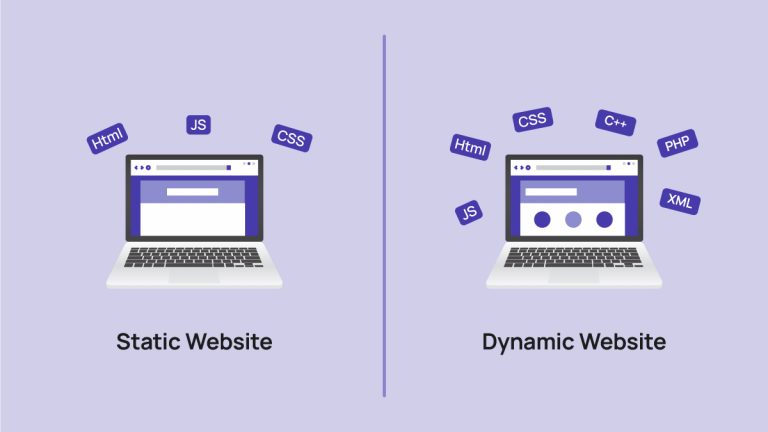
Selecting the right type of website for your business is crucial to ensuring it meets your specific needs and objectives. Let’s explore the characteristics of static and dynamic websites, and provide guidance on making an informed decision:
Static Websites
Static websites, also known as nondynamic websites, present the same content to every visitor. Here are the key attributes of static websites:
1. Simplicity and Speed.
Uniform Content: Every user sees the same content.
Fast Load Times: Generally faster to load as they consist of simple HTML files.
Ease of Setup: Simple to set up and host, requiring minimal technical expertise.
2. Low Maintenance.
Infrequent Updates: Ideal for sites where the content doesn’t change frequently, such as brochures, portfolios, or informational pages.
Security: Less susceptible to certain types of cyberattacks since they don’t connect to databases.
3. Cost Effective.
Lower Costs: Less expensive to develop and maintain compared to dynamic websites.
Suitable for Small Businesses: Ideal for startups or small businesses with limited budgets.
Dynamic Websites
Dynamic websites provide personalized content tailored to individual users. They are characterized by:
1. Personalized User Experience.
Variable Content. Content changes based on user interactions, location, device type, or other criteria.
Interactive Features: Capabilities such as user accounts, forms, and ecommerce functionalities.
2. Content Management Systems (CMS):
Ease of Updates: Utilizes CMS like WordPress, Joomla, or Drupal, making it easier to update and manage content without extensive technical knowledge.
Scalability: Better suited for businesses that need to update content regularly or offer a variety of content types.
3. Enhanced Functionality.
Complex Features: Supports advanced features like blogs, forums, and social media integration.
User Engagement: Better for businesses aiming for high user engagement and frequent interaction.
Making the Right Choice
To determine which type of website suits your business best, consider the following factors:
1. Content Nature and Frequency.
Static Website: Best if your content is stable and does not require frequent updates.
Dynamic Website: Necessary if you plan to update content regularly or need interactive features.
2. User Experience and Engagement:
Static Website: Suitable for providing straightforward information without requiring user interaction.
Dynamic Website: Ideal for engaging users with personalized content and interactive elements.
3. Budget and Resources.
Static Website: More cost effective, both in terms of initial setup and ongoing maintenance.
Dynamic Website: Higher initial cost and maintenance but offers greater flexibility and functionality.
4. Technical Expertise:
Static Website: Requires minimal technical skills for setup and maintenance.
Dynamic Website: Often requires ongoing technical support, especially for custom features and integrations.
5. Long term Goals:
Static Website: Works well for businesses with a stable, long term content strategy.
Dynamic Website: Better for businesses planning to expand, frequently update content, or provide a high level of user interaction.
Conclusion
Choosing between a static and dynamic website depends on your business’s specific needs, goals, and resources. Static websites offer simplicity, speed, and cost effectiveness, making them ideal for small businesses or those with stable content. Dynamic websites, on the other hand, provide flexibility, interactivity, and scalability, suitable for businesses aiming for high user engagement and regular content updates.
By carefully evaluating the nature of your content, user engagement needs, budget, and long term objectives, you can select the website type that best supports your business strategy and enhances the user experience.
1. Which type of website is better for search engine optimization (SEO)?
Both static and dynamic websites can be optimized for search engines, but dynamic websites typically offer more flexibility in terms of content creation and optimization. Dynamic websites, especially those built on content management systems (CMS) like WordPress or Joomla, allow for regular content updates, which can improve SEO by keeping the site fresh and relevant. However, static websites can still rank well if properly optimized with meta tags, keyword rich content, and other SEO best practices.
2. Can I convert my static website to a dynamic one later if my business needs change?
Yes, it’s possible to convert a static website to a dynamic one, although it may require significant changes to the site’s structure and functionality. Depending on the complexity of the conversion, you may need to migrate your content to a CMS platform, implement database driven features, and redesign the site layout to accommodate dynamic elements. While this process can be time consuming and costly, it allows businesses to adapt to changing needs and take advantage of the benefits of dynamic websites in the future.
3. How do I decide if my business needs a static or dynamic website?
The decision between a static and dynamic website depends on various factors, including the nature of your content, budget, technical expertise, and long term goals. Consider the following questions:
Is your content stable, or will it require frequent updates?
Do you need interactive features like user accounts, forms, or ecommerce functionalities?
What is your budget for website development and maintenance?
Do you have the technical skills or resources to manage a dynamic website?
Are you planning to expand your business or regularly update content in the future?
Based on your answers to these questions, you can determine which type of website aligns best with your business needs and objectives.



